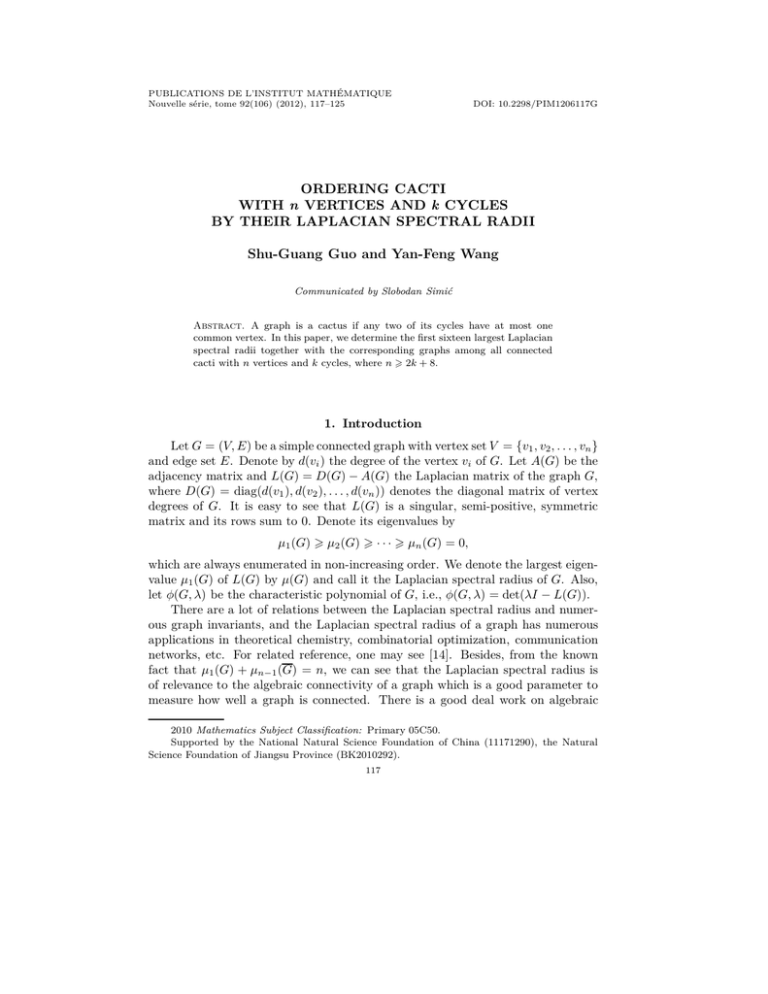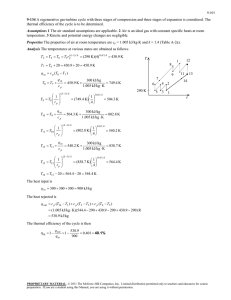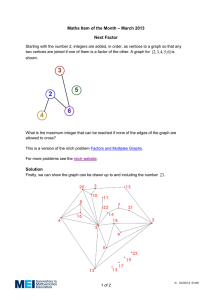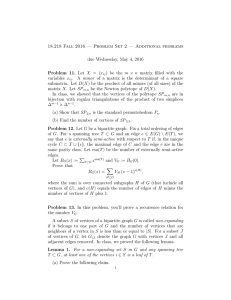PUBLICATIONS DE L’INSTITUT MATHÉMATIQUE Nouvelle série, tome 92(106) (2012), 117–125 DOI: 10.2298/PIM1206117G
advertisement

PUBLICATIONS DE L’INSTITUT MATHÉMATIQUE
Nouvelle série, tome 92(106) (2012), 117–125
DOI: 10.2298/PIM1206117G
ORDERING CACTI
WITH n VERTICES AND k CYCLES
BY THEIR LAPLACIAN SPECTRAL RADII
Shu-Guang Guo and Yan-Feng Wang
Communicated by Slobodan Simić
Abstract. A graph is a cactus if any two of its cycles have at most one
common vertex. In this paper, we determine the first sixteen largest Laplacian
spectral radii together with the corresponding graphs among all connected
cacti with n vertices and k cycles, where n > 2k + 8.
1. Introduction
Let G = (V, E) be a simple connected graph with vertex set V = {v1 , v2 , . . . , vn }
and edge set E. Denote by d(vi ) the degree of the vertex vi of G. Let A(G) be the
adjacency matrix and L(G) = D(G) − A(G) the Laplacian matrix of the graph G,
where D(G) = diag(d(v1 ), d(v2 ), . . . , d(vn )) denotes the diagonal matrix of vertex
degrees of G. It is easy to see that L(G) is a singular, semi-positive, symmetric
matrix and its rows sum to 0. Denote its eigenvalues by
µ1 (G) > µ2 (G) > · · · > µn (G) = 0,
which are always enumerated in non-increasing order. We denote the largest eigenvalue µ1 (G) of L(G) by µ(G) and call it the Laplacian spectral radius of G. Also,
let φ(G, λ) be the characteristic polynomial of G, i.e., φ(G, λ) = det(λI − L(G)).
There are a lot of relations between the Laplacian spectral radius and numerous graph invariants, and the Laplacian spectral radius of a graph has numerous
applications in theoretical chemistry, combinatorial optimization, communication
networks, etc. For related reference, one may see [14]. Besides, from the known
fact that µ1 (G) + µn−1 (G) = n, we can see that the Laplacian spectral radius is
of relevance to the algebraic connectivity of a graph which is a good parameter to
measure how well a graph is connected. There is a good deal work on algebraic
2010 Mathematics Subject Classification: Primary 05C50.
Supported by the National Natural Science Foundation of China (11171290), the Natural
Science Foundation of Jiangsu Province (BK2010292).
117
118
GUO AND WANG
connectivity for graphs (see [1] and references therein), and particular attention
has been paid to algebraic connectivity for unicyclic graphs (see [3] for example).
Recently, the problem concerning graphs with maximal or minimal Laplacian
spectral radius of a given class of graphs has been studied extensively. For related
results, one may refer to [4–13] and the references therein.
A graph is a cactus, or a treelike graph, if any two of its cycles have at most
one common vertex. Cacti have been studied by several authors, for example, one
may see [2,15]. Let Tn,k denote the set of all connected cacti with n vertices and k
cycles.
When k = 1, Tn,1 is the set of all unicyclic graphs of order n. Let Ti (i =
1–4, 6, 8–11, 13–19) be the unicyclic graphs with n vertices shown in Fig. 2. Let
T ∈ Tn,1 and T ∈
/ {T1 , T2 , T3 , T4 }. Guo [7] proved that
n = µ(T1 ) > µ(T2 ) > µ(T3 ) > µ(T4 ) > µ(T ).
Let T ∈ Tn,1 and T ∈
/ {T1 , T2 , T3 , T4 , T6 , T8 , T9 , T10 , T11 , T17 }. Liu, Shao and Yuan
[11] proved that
µ(T6 ) > µ(T8 ) > µ(T9 ) > µ(T10 ) > µ(T11 ) = µ(T17 ) > µ(T ).
Let T ∈ Tn,1 and T ∈
/ {T1 , T2 , T3 , T4 , T6 , T8 , T9 , T10 , T11 , T17 , T13 –T16 , T18 , T19 }. Liu
and Liu [12] proved that
µ(T13 ) > µ(T14 ) = µ(T18 ) = µ(T19 ) > µ(T15 ) > µ(T16 ) > µ(T ).
In this paper, we consider the cases when k > 2, and determine the first sixteen
largest Laplacian spectral radii together with the corresponding graphs in Tn,k .
2. Preliminaries
For v ∈ V (G), N (v) denotes the set of all neighbors of vertex v in G. Then
d(v) = |N (v)|. ∆ denotes the maximum degree of G and δ denotes the minimum
degree of G. Let G1 , G2 , . . . , G20 be the cacti with n vertices and k cycles shown
in Fig. 1.
P Lemma 2.1 (13). We have µ(G) 6 max{d(v) + m(v) : v ∈ V }, where m(v) =
u∈N (v) d(u)/d(v).
Lemma 2.2. Suppose k > 1 and G ∈ Tn,k with ∆ 6 n − 4. If n > 2k + 8, then
µ(G) 6 n − 2.
Proof. By Lemma 2.1, we only need to prove that max{d(v) + m(v) : v ∈
V (G)} 6 n − 2. Suppose max{d(v) + m(v) : v ∈ V (G)} occurs at the vertex u. We
consider the following three cases.
Case 1. d(u) = 1. Suppose v ∈ N (u), then
d(u) + m(u) = d(u) + d(v) 6 1 + n − 4 < n − 2.
Case 2. d(u) = 2. Suppose v, w ∈ N (u). Note that G is a cactus, then
|N (v) ∩ N (w)| 6 2 and |N (v) ∪ N (w)| 6 n. Therefore
d(u) + m(u) = 2 +
d(v) + d(w)
n+2
62+
6 n − 2.
2
2
ORDERING CACTI WITH n VERTICES AND k CYCLES
119
Case 3. 3 6 d(u) 6 n − 4. Note that 3 6 d(u) 6 n − 4, then
d(u) + m(u) 6 d(u) +
2m − d(u) − 3
2m − 3
= d(u) − 1 +
.
d(u)
d(u)
Next we shall prove that d(u)−1+ 2m−3
d(u) 6 n−2. Equivalently, d(u)(n−1−d(u))
> 2m − 3. Once this is proved, we are done. Let f (x) = (n − 1 − x)x.
′
When x ∈ [3, n−1
2 ], since f (x) = n − 1 − 2x > 0, then
f (x) > f (3) = 3(n − 4) > 2(n + k − 1) − 3 = 2m − 3.
′
When x ∈ [ n−1
2 , n − 4], since f (x) = n − 1 − 2x 6 0, then
f (x) > f (n − 4) = 3(n − 4) > 2(n + k − 1) − 3 = 2m − 3.
120
GUO AND WANG
By combing the above discussion, the conclusion follows.
Lemma 2.3 (4). Let v be a vertex in a connected graph G and suppose that s
(s > 2) new paths (with equal length k) Pi : vvik vi(k−1) . . . vi1 , (i = 1, 2, . . . , s;
k > 1) are attached to G at v, respectively, to form a new graph Gks , where
vik , vi(k−1) , . . . , vi1 , (i = 1, 2, . . . , s) are distinct new vertices. Let Gks;t1 ,t2 ,...,tk
be the graph obtained from Gks by adding ti (0 6 ti 6 s(s−1)
) edges among ver2
tices v1i , v2i , . . . , vsi (1 6 i 6 k), respectively. If ∆(Gks ) > s + 3, then we have
µ(Gks;t1 ,t2 ,...,tk ) = µ(Gks ).
Let T1 , T2 , . . . , T16 be the graphs with n vertices shown in Fig. 2. Then from
Lemma 2.3, we can obtain easily the following lemma.
Lemma 2.4. µ(G1 ) = µ(T1 ), µ(G2 ) = µ(T2 ), µ(G3 ) = µ(T3 ), µ(G4 ) = µ(T4 ),
µ(G5 ) = µ(T5 ), µ(G6 ) = µ(T6 ), µ(G7 ) = µ(T7 ), µ(G8 ) = µ(T8 ), µ(G9 ) = µ(G10 ) =
µ(T9 ), µ(G11 ) = µ(T10 ), µ(G12 ) = µ(G13 ) = µ(T11 ), µ(G14 ) = µ(T12 ), µ(G15 ) =
µ(T13 ), µ(G16 ) = µ(G17 ) = µ(G18 ) = µ(T14 ), µ(G19 ) = µ(T15 ), µ(G20 ) = µ(T16 ).
Lemma 2.5 (6). Let G be a connected graph on n vertices with at least one
edge; then µ(G) > ∆(G) + 1, where ∆(G) is the maximum degree of the graph G,
with equality if and only if ∆(G) = n − 1.
ORDERING CACTI WITH n VERTICES AND k CYCLES
121
Lemma 2.6. Let n > 10. Then n = µ(T1 ) > µ(T2 ) > µ(T3 ) > µ(T4 ) > µ(T5 ) >
µ(T6 ) > µ(T7 ) > µ(T8 ) > µ(T9 ) > µ(T10 ) > µ(T11 ) > µ(T12 ) > µ(T13 ) > µ(T14 ) >
µ(T15 ) > µ(T16 ).
Proof. From [7] we have n = µ(T1 ) > µ(T2 ) > µ(T3 ) > µ(T4 ), and µ(Ti ) is
the largest root of the equation hi (λ) = 0 (i = 2, 3, 4), respectively, where
h2 (λ) = λ4 − (n + 5)λ3 + (6n + 4)λ2 − (10n − 4)λ + 4n,
h3 (λ) = λ4 − (n + 5)λ3 + (6n + 3)λ2 − (9n − 5)λ + 3n,
h4 (λ) = λ4 − (n + 5)λ3 + (6n + 4)λ2 − (10n − 6)λ + 3n.
It is not difficult to calculate recursively that
φ(T5 ; λ) = λ(λ − 1)n−8 (λ3 − 6λ2 + 10λ − 4)h5 (λ),
φ(T6 ; λ) = λ(λ − 1)n−5 h6 (λ),
φ(T7 ; λ) = λ(λ − 1)n−8 h7 (λ),
φ(T8 ; λ) = λ(λ − 2)(λ − 1)n−7 h8 (λ),
φ(T9 ; λ) = λ(λ − 1)n−5 h9 (λ),
φ(T10 ; λ) = λ(λ − 2)(λ − 1)n−6 h10 (λ),
φ(T11 ; λ) = λ(λ − 1)n−5 h11 (λ),
φ(T12 ; λ) = λ(λ − 1)n−8 h12 (λ),
φ(T13 ; λ) = λ(λ − 1)n−7 h13 (λ),
φ(T14 ; λ) = λ(λ − 3)(λ − 1)n−7 (λ2 − 3λ + 1)h14 (λ),
φ(T15 ; λ) = λ(λ − 1)n−6 h15 (λ),
φ(T16 ; λ) = λ(λ − 3)(λ − 1)n−6 h16 (λ),
where
h5 (λ) = λ4 − (n + 4)λ3 + (6n − 2)λ2 − (10n − 12)λ + 4n,
h6 (λ) = λ4 − (n + 5)λ3 + (7n − 1)λ2 − (13n − 19)λ + 4n,
h7 (λ) = λ7 − (n + 10)λ6 + (12n + 31)λ5 − (55n + 14)λ4 + (121n − 85)λ3
− (132n − 128)λ2 + (66n − 44)λ − 12n,
h8 (λ) = λ5 − (n + 5)λ4 + (7n + 1)λ3 − (15n − 17)λ2 + (10n − 8)λ − 2n,
h9 (λ) = λ4 − (n + 5)λ3 + (7n − 3)λ2 − (11n − 17)λ + 3n,
h10 (λ) = λ4 − (n + 4)λ3 + (6n − 4)λ2 − (8n − 12)λ + 2n,
h11 (λ) = λ4 − (n + 5)λ3 + (7n − 1)λ2 − (13n − 21)λ + 3n,
h12 (λ) = λ7 − (n + 10)λ6 + (12n + 30)λ5 − (54n + 8)λ4 + (114n − 93)λ3
− (117n − 126)λ2 + (54n − 39)λ − 9n,
122
GUO AND WANG
h13 (λ) = λ6 − (n + 7)λ5 + (9n + 10)λ4 − (28n − 18)λ3 + (36n − 42)λ2
− (18n − 14)λ + 3n,
3
h14 (λ) = λ − (n + 1)λ2 + (3n − 5)λ − n,
h15 (λ) = λ5 − (n + 6)λ4 + (8n + 4)λ3 − (20n − 22)λ2 + (17n − 26)λ − 3n,
h16 (λ) = λ4 − (n + 3)λ3 + (5n − 4)λ2 − (6n − 10)λ + n.
Since n > µ(Ti ) > ∆(Ti ) + 1 > n − 2 > 8, it follows that µ(Ti ) is the largest
root of the equation hi (λ) = 0(i = 5, . . . , 16) respectively. Next we shall divide the
proof into the next 11 steps.
(1) µ(T4 ) > µ(T5 ). It is easy to see that h4 (λ) = h5 (λ) − (λ2 (λ − 6) + 6λ + n)
and h4 (µ(T5 )) < 0. So we have µ(T4 ) > µ(T5 ).
(2) µ(T5 ) > µ(T6 ). Note that h5 (λ) = h6 (λ) + γ1 (λ), where
γ1 (λ) = λ(λ2 − (n + 1)λ + 3n − 7).
Let α1 denote the maximum root of γ1 (λ) = 0. Since γ1 (−1) < 0, γ1 (2) > 0,
γ1 (n − 2) < 0, γ1 (n − 1) > 0, it is easy to see that n − 2 < α1 < n − 1.
Note that h6 (λ) = (λ−4)γ1 (λ)+(2λ2 −(n+9)λ+4n), then h6 (λ) > 0 for λ > α1 .
Thus µ(T6 ) < α1 . Note that limλ→∞ γ1 (λ) = +∞, thus h5 (µ(T6 )) = γ1 (µ(T6 )) < 0.
This implies that µ(T5 ) > µ(T6 ).
(3) µ(T6 ) > µ(T7 ). It is easy to see that h7 (λ) = γ2 (λ)h6 (λ) + γ3 (λ), where
γ2 (λ) = (λ − 1)2 (λ − 3),
γ3 (λ) = λ(2λ2 − 8λ − n + 13).
Since µ(T7 ) > n − 2 > 8, it follows that γ2 (µ(T7 )) > 0 and γ3 (µ(T7 )) > 0. This
implies that h6 (µ(T7 )) < 0. Thus µ(T6 ) > µ(T7 ).
(4) µ(T7 ) > µ(T8 ). It is easy to see that h7 (λ) = (λ2 − 5λ + 5)h8 (λ) − γ4 (λ),
where
γ4 (λ) = λ4 − (n + 3)λ3 + (5n − 3)λ2 − (6n − 4)λ + 2n
= λ2 (λ2 − (n + 3)λ + 5n − 10) + (7λ2 − (6n − 4)λ + 2n).
It is easy to see that γ4 (µ(T8 )) > 0. So we have h7 (µ(T8 )) < 0, thus µ(T7 ) > µ(T8 ).
(5) From [11] we have µ(T8 ) > µ(T9 ) > µ(T10 ).
(6) µ(T10 ) > µ(T11 ). Note that h10 (λ) = h11 (λ) + γ5 (λ), where
γ5 (λ) = λ3 − (n + 3)λ2 + (5n − 9)λ − n.
Let α2 denote the maximum root of γ5 (λ) = 0. Since γ5 (−∞) < 0, γ5 ( 12 ) =
5n
41
4 − 8 > 0, γ5 (n − 2) < 0, γ5 (n − 1) > 0, thus n − 2 < α2 < n − 1.
Note that h11 (λ) = (λ − 2)γ5 (λ) + 2λ2 − (2n − 3)λ + n, then h11 (α2 ) = 2α22 −
(2n − 3)α2 + n > 0 and h11 (λ) > 0 for λ > α2 . Thus µ(T11 (λ)) < α2 . Note
that limλ→∞ γ5 (λ) = +∞, thus h10 (µ(T11 )) = γ5 (µ(T11 )) < 0. This implies that
µ(T10 ) > µ(T11 ), because limλ→∞ h10 (λ) = +∞.
(7) µ(T11 ) > µ(T12 ). Note that h12 (λ) = γ6 (λ)h11 (λ) − γ7 (λ), where
γ6 (λ) = λ3 − 5λ2 + 6λ − 4, γ7 (λ) = 2λ3 − (4n − 4)λ2 + (16n − 45)λ − 3n.
ORDERING CACTI WITH n VERTICES AND k CYCLES
123
It is easy to see that γ6 (µ(T12 )) > 0. Note that γ7 (−∞) < 0, γ7 (1) > 0,
γ7 (n − 1) < 0, γ7 (n − 2) < 0, γ7 (+∞) > 0 and n − 2 < µ(T12 ) < n − 1. It
follows that γ7 (µ(T12 )) < 0. So we have h11 (µ(T12 )) < 0, thus µ(T11 ) > µ(T12 ).
(8) µ(T12 ) > µ(T13 ). Note that h12 (λ) = (λ − 3)h13 (λ) − γ8 (λ), where
γ8 (λ) = λ5 − (n + 4)λ4 + (6n − 3)λ3 − (9n − 14)λ2 + (3n − 3)λ.
We also have h12 (λ) = (λ − 3)2 γ8 (λ) − γ9 (λ), where
γ9 (λ) = 4λ4 − (3n + 21)λ3 + (18n + 18)λ2 − (27n − 12)λ + 9n
= 3λ4 − (3n − 6)λ3 + λ2 (λ2 − 27λ + 18n − 15) + 33λ2 − (27n − 12)λ + 9n.
It is easy to see that γ9 (λ) > 0 for λ > µ(T12 ). So we have γ8 (λ) > 0 for λ > µ(T12 ).
Thus h13 (λ) > 0 for λ > µ(T12 ). It follows that µ(T12 ) > µ(T13 ).
(9) µ(T13 ) > µ(T14 ). Note that h13 (λ) = (λ3 − 6λ2 + 9λ − 3)h14 (λ) − λ. It is
easy to see that h13 (µ(T14 )) < 0. Thus µ(T13 ) > µ(T14 ).
(10) µ(T14 ) > µ(T15 ). Note that h15 (λ) = (λ2 − 5λ + 4)h14 (λ) + (λ2 − 6λ + n).
It is easy to see that h14 (µ(T15 )) < 0. Thus µ(T14 ) > µ(T15 ).
(11) µ(T15 ) > µ(T16 ). Note that h15 (λ) = (λ − 3)h16 (λ) − λ(λ2 − nλ + 2n − 4).
It is easy to see that h15 (µ(T16 )) < 0. Thus µ(T15 ) > µ(T16 ).
By combining the above discussion, we have µ(T4 ) > µ(T5 ) > µ(T6 ) > µ(T7 ) >
µ(T8 ) > µ(T9 ) > µ(T10 ) > µ(T11 ) > µ(T12 ) > µ(T13 ) > µ(T14 ) > µ(T15 ) >
µ(T16 ).
3. Main results
Theorem 3.1. Let G be a connected cactus with n vertices and k cycles, and
G1 , G2 , . . . , G20 be the cacti with n vertices and k cycles shown in Fig. 1, where
k > 2 and n > 2k + 8.
(1) If G ∈
/ {G1 , . . . , G20 }, then µ(G) 6 n − 2 < µ(G20 ).
(2) n = µ(G1 ) > µ(G2 ) > µ(G3 ) > µ(G4 ) > µ(G5 ) > µ(G6 ) > µ(G7 ) >
µ(G8 ) > µ(G9 ) = µ(G10 ) > µ(G11 ) > µ(G12 ) = µ(G13 ) > µ(G14 ) > µ(G15 ) >
µ(G16 ) = µ(G17 ) = µ(G18 ) > µ(G19 ) > µ(G20 ), and µ(Gi ) is the largest root of the
equation fi (λ) = 0(i = 2, . . . , 20) respectively, where
f2 (λ) = λ4 − (n + 5)λ3 + (6n + 4)λ2 − (10n − 4)λ + 4n,
f3 (λ) = λ4 − (n + 5)λ3 + (6n + 3)λ2 − (9n − 5)λ + 3n,
f4 (λ) = λ4 − (n + 5)λ3 + (6n + 4)λ2 − (10n − 6)λ + 3n,
f5 (λ) = λ4 − (n + 4)λ3 + (6n − 2)λ2 − (10n − 12)λ + 4n,
f6 (λ) = λ4 − (n + 5)λ3 + (7n − 1)λ2 − (13n − 19)λ + 4n,
f7 (λ) = λ7 − (n + 10)λ6 + (12n + 31)λ5 − (55n + 14)λ4 + (121n − 85)λ3
− (132n − 128)λ2 + (66n − 44)λ − 12n,
f8 (λ) = λ5 − (n + 5)λ4 + (7n + 1)λ3 − (15n − 17)λ2 + (10n − 8)λ − 2n,
f9 (λ) = f10 (λ) = λ4 − (n + 5)λ3 + (7n − 3)λ2 − (11n − 17)λ + 3n,
124
GUO AND WANG
f11 (λ) = λ4 − (n + 4)λ3 + (6n − 4)λ2 − (8n − 12)λ + 2n,
f12 (λ) = f13 (λ) = λ4 − (n + 5)λ3 + (7n − 1)λ2 − (13n − 21)λ + 3n,
f14 (λ) = λ7 − (n + 10)λ6 + (12n + 30)λ5 − (54n + 8)λ4 + (114n − 93)λ3
− (117n − 126)λ2 + (54n − 39)λ − 9n,
f15 (λ) = λ6 − (n + 7)λ5 + (9n + 10)λ4 − (28n − 18)λ3 + (36n − 42)λ2
− (18n − 14)λ + 3n,
f16 (λ) = f17 (λ) = f18 (λ) = λ3 − (n + 1)λ2 + (3n − 5)λ − n,
f19 (λ) = λ5 − (n + 6)λ4 + (8n + 4)λ3 − (20n − 22)λ2 + (17n − 26)λ − 3n,
f20 (λ) = λ4 − (n + 3)λ3 + (5n − 4)λ2 − (6n − 10)λ + n.
Proof. It is easy to check that G1 , G2 , . . . , G20 are all the cacti with n vertices,
k cycles and maximum degree greater than n − 4. Then ∆(G) 6 n − 4 for G ∈
/
{G1 , . . . , G20 }. By Lemma 2.2, we have µ(G) 6 n − 2. By Lemmas 2.4 and 2.6,
µ(G20 ) = µ(T16 ) is the largest root of the equation
f20 (λ) = h16 (λ) = λ4 − (n + 3)λ3 + (5n − 4)λ2 − (6n − 10)λ + n = 0.
Since h16 (n − 2) = −n + 4 < 0, it follows that µ(G20 ) > n − 2. Thus
µ(G) 6 n − 2 < µ(G20 ).
This completes the proof of (1).
The proof of (2) follows from Lemma 2.4, Lemma 2.6 and the proof of Lemma
2.6 immediately.
References
1. N. M. M. Abreu, Old and new results on algebraic connectivity of graphs, Linear Algebra Appl.
423(1) (2007), 53–73.
2. B. Borovićanin, M. Petrović, On the index of cactuses with n vertices, Publ. Inst. Math.
(Beograd) 79(93) (2006), 13-18.
3. S. Fallat, S. Kirkland, S. Pati, Maximizing algebraic connectivity over unicyclic graphs, Linear
Multilinear Algebra 51(3) (2003), 221–241.
4. J. M. Guo, The Laplacian spectral radius of a graph under perturbation, Comput. Math. Appl.
54 (2007), 709–720.
5. J. M. Guo, On the Laplacian spectral radius of a tree, Linear Algebra Appl. 368 (2003), 379–
385.
6. R. Grone, R. Merris, The Laplacian spectrum of graph II, SIAM J. Discrete Math. 7 (1994),
221–229.
7. S. G. Guo, The largest eigenvalues of the Laplacian matrices of unicyclic graphs, Appl. Math.
J. Chinese Univ. Ser. A 16(2) (2001), 131–135. (in Chinese)
8. S. G. Guo, Ordering trees with n vertices and diameter d by their largest Laplacian eigenvalues, Util. Math. 74 (2007), 65–69.
9. S. G. Guo, Ordering trees with n vertices and matching number q by their largest Laplacian
eigenvalues, Discrete Math. 308 (2008), 4608–4615.
10. C. X. He, J. Y. Shao, J. L. He, On the Lapalcian spectral radii of bicyclic graphs, Discrete
Math. 308(24) (2008), 5981–5995.
11. Y. Liu, J. Y. Shao, X. Y. Yuan, Some results on the ordering of the Laplacian spectral radii
of unicyclic graphs, Discrete Appl. Math. 156(14) (2008), 2679–2697.
ORDERING CACTI WITH n VERTICES AND k CYCLES
125
12. Y. Liu, Y. Liu, Ordering of unicyclic graphs with Laplacian spectral radii, J. Tongji Univ. 36
(2008), 841–843. (in Chinese)
13. R. Merris, A note on Laplacian graph eigenvalues, Linear Algebra Appl. 285 (1998), 33–35.
14. B. Mohar, Some applications of Laplace eigenvalues of graphs. Notes taken by Martin Juvan,
(English), in: G. Hahn et al. (Eds.) Graph Symmetry: Algebraic Methods and Applications,
NATO ASI Ser., Ser.C, Math. Phys. Sci., vol. 497, Kluwer, Dordrecht, 1997, 225–275.
15. Z. Radosavljević, M. Ras̆ajski, A class of reflexive cactuses with four cycles, Univ. Beograd
Publ. Elektrotehn. Fak., Ser. Mat. 14 (2003), 64–85.
School of Mathematical Sciences
Yancheng Teachers University
Yancheng 224002, Jiangsu
P. R. China
ychgsg@yahoo.com.cn
(Received 20 04 2010)
(Revised 18 05 2011)






